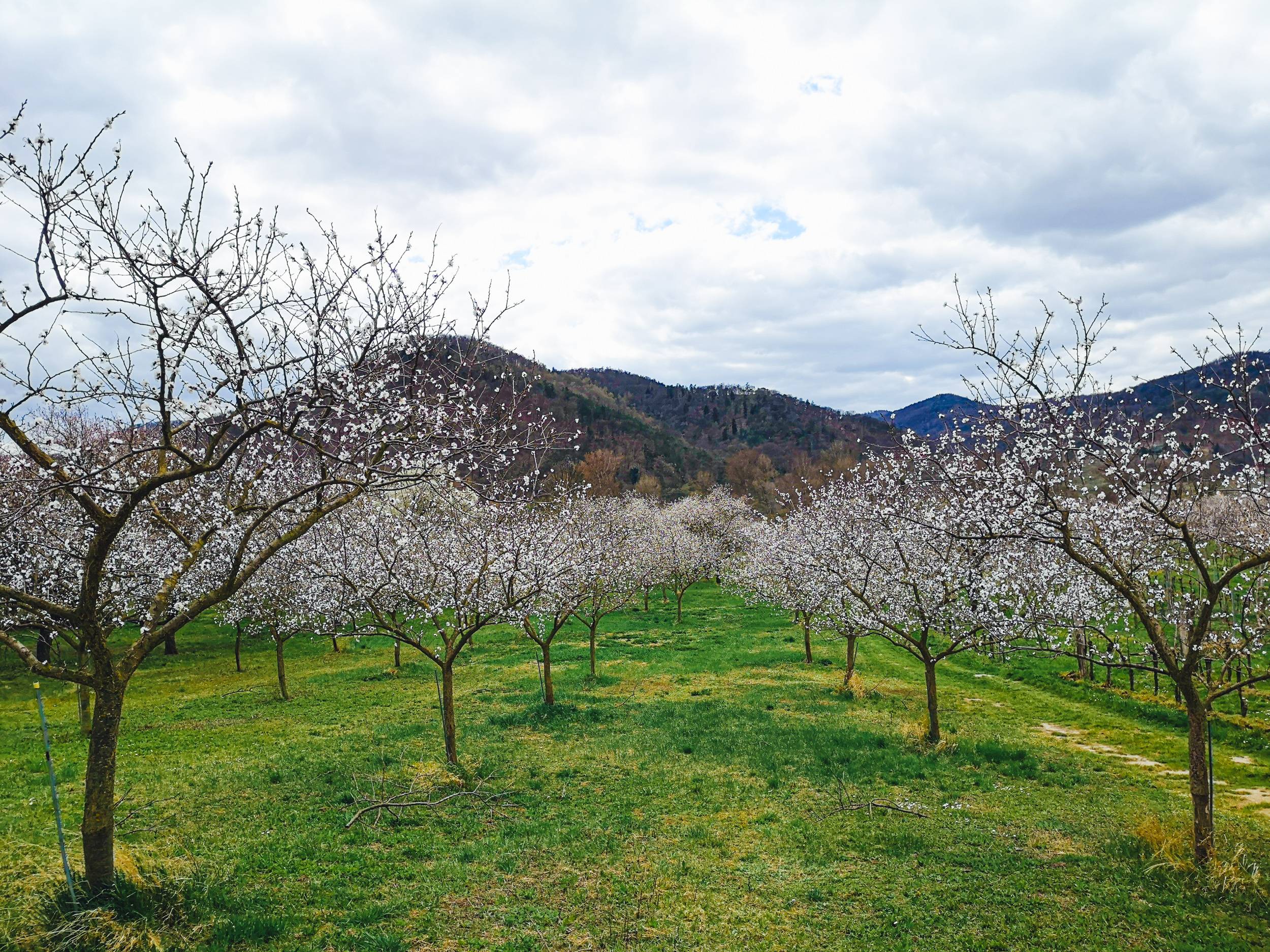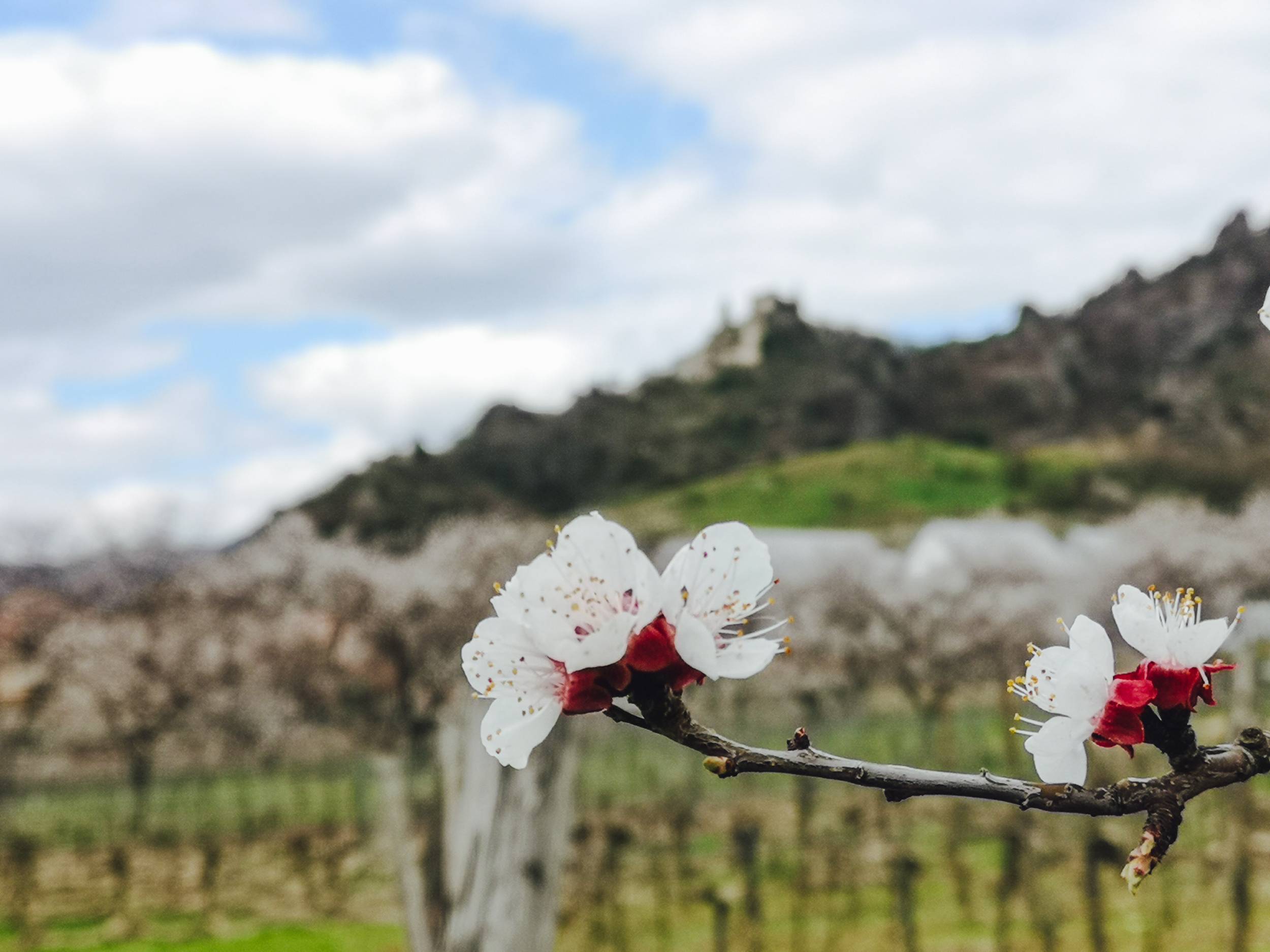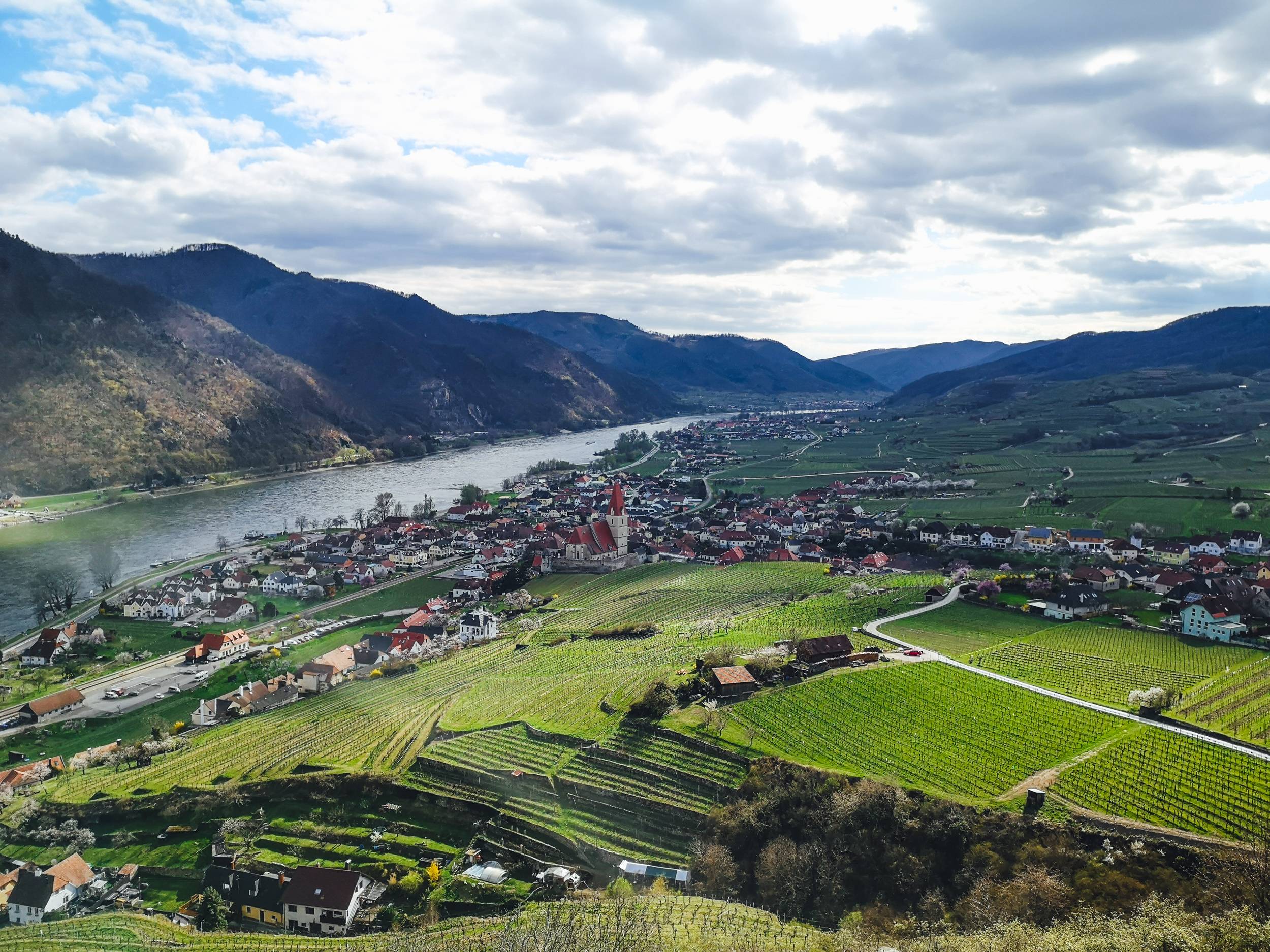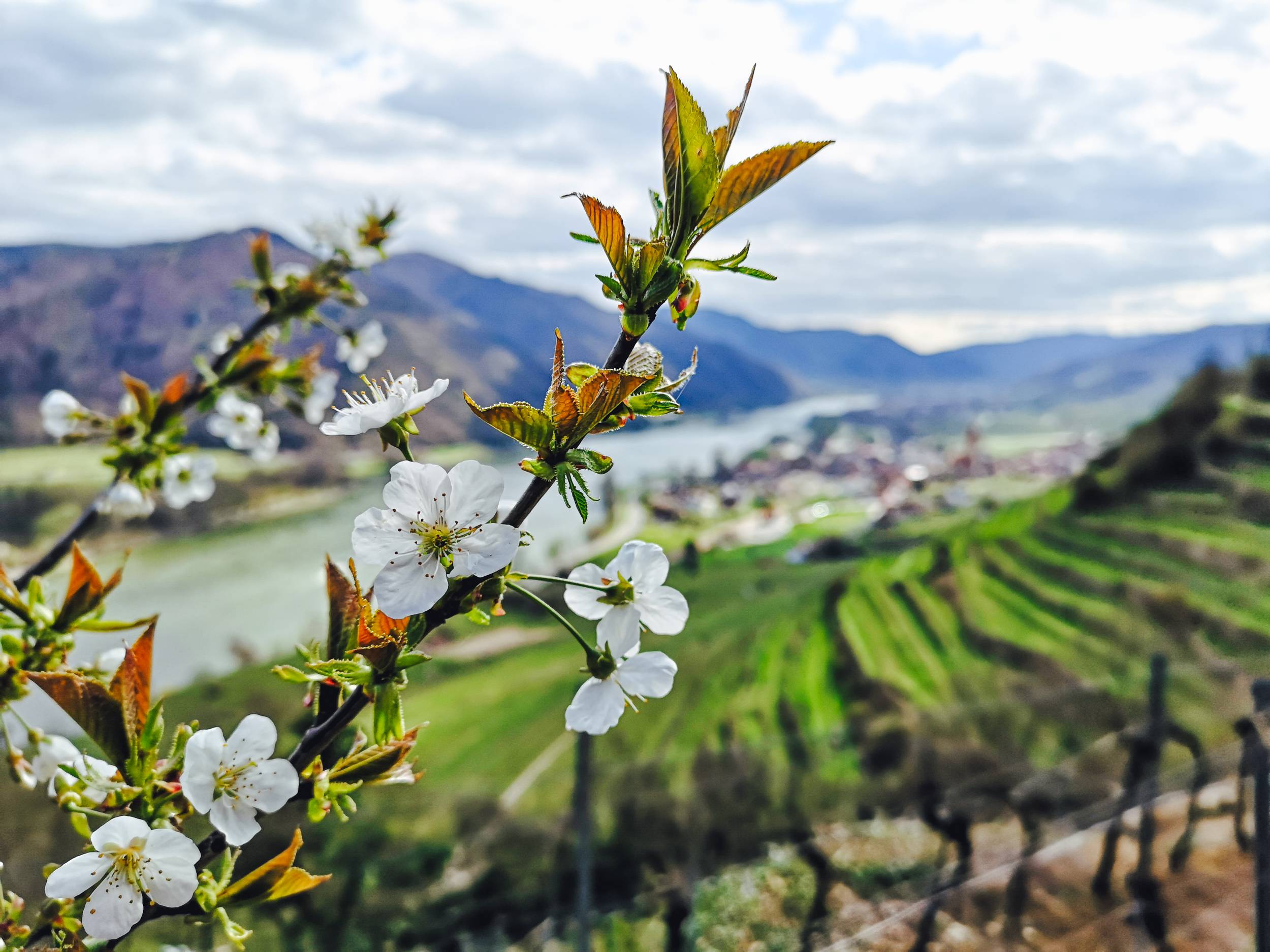Top attractions:
Quick Navigation
About Wachau Valley
Wachau Valley is always a treat, but spring might be THE time to visit this ever-picturesque region. The reason for it – apricot blossoms. One could think that every corner of the world touched by seasons is most beautiful during the wake of spring but blooming apricots are a special time in Wachau. You see, the gorgeous landscape of this valley comes with a price. The terrain of Wachau is rather difficult to grow anything on, thus not many plants could be cultivated here. Together with vines, apricots are the only cultures to be grown commercially in Wachau. Just like its wines, the Wachau apricot is a worldwide recognized product. No wonder, the blooming period of these trees is special in the valley.

Apricots color the Wachau Valley in pastel pink every spring for about a week. Photo by Alis Monte [CC BY-SA 4.0], via Connecting the Dots
History of Wachau Apricot
How exactly apricots came to Wachau is not known but what is certain that it is not native to the area. First apricots have originated in the territory of China. Its migration route is unknown but it predates even the Roman Empire. Actually, the first humans flying to the moon are closer in time to the great empire than the first apricots in the Wachau Valley. It is proved that these trees had been cultivated in the area for more than 4000 years. Today, Wachau Apricot has a protected designation of origin, and it is known for its special unrivaled sweet taste.
Wachau Apricot Blossom Details
- Location: Wachau and Kremstal
- Region: Lower Austria
- Date: Late March – early April
- Accomodation: Dürnstein & Weissenkirchen
- Forecast: Dürnstein weather
- Best locations: Dürnstein and Rossatz-Arnsdorf
Map of Wachau Valley
Best Time for Apricot Blossoms in Wachau
Wachau Valley colors itself in Apricot pink just for a brief period of time. This magical phase only lasts for about a week. The exact time is hard to predict as nature works not entirely like clockwork, but apricots usually begin to bloom between the end of March and the beginning of April. In 2021 the first apricot blossoms appeared on 30th March and by 4th April they were already on their way off.

Apricots bloom for about a week a year. Photo by Alis Monte [CC BY-SA 4.0], via Connecting the Dots
Best Places to See Apricot Blossoms
Without a doubt, you’ll find apricots across the Wachau Valley, but picking the right place might be important. For example, Rossatz-Arnsdorf is the largest Apricot growing community in Austria, therefore if your sole purpose is blooming apricots – consider picking this destination. If you want to combine this beautiful time of year with the idyllic Wachau setting, you might want to go to one of the magical towns found in the valley like Weissenkirchen, Spitz or Dürnstein.
Marillenmeile Ost 1 red, Rossatz-Arnsdorf
- Distance: 4.57 km / 2.84 mi
- Ascend: 50 m / 164 ft
- Type: Circle
- Duration: 1-2h
- Difficulty: Easy

Wachau apricots during early summer in Rossatz-Arnsdorf. Photo by Alis Monte [CC BY-SA 4.0], via Connecting the Dots
Marillenweg (eng. Apricot trail), Angern
- Distance: ~5 km / 3.1 mi
- Ascend: 120 m / 394 ft
- Type: Circle
- Duration: 1-2h
- Difficulty: Easy
Oberloiben, Dürnstein
Dürnstein is probably the most diverse town in the whole stretch of the Wachau Valley. It is no surprise that among many things it has to offer, apricot fields are one of them. If you are interested to plan a full-day trip to this medieval town, the full guide to Dürnstein and its history mind be handy.
- Distance: 1.8 km / 1.12 mi
- Ascend: Flat
- Type: Circle
- Duration: 1h
- Difficulty: Easy

There are more than enough of apricots for casual visitors in Oberloiben area of Dürnstein. Photo by Alis Monte [CC BY-SA 4.0], via Connecting the Dots
Wachau Valley Tours
From what I heard, Wachau ferries are a great way to experience the pastel pink Wachau during the blooming time of apricots. Of course, it wouldn’t be my personal choice as I prefer to experience it personally, but I imagine it would be quite a magnificent view. Also, besides bicycles ferries are the only viable option to see the whole range of Wachau within a day.
If you decide to take one, I suggest doing it via GetYourGuide. This way you’ll get guaranteed quality service and the ability to cancel your tour up to 24 hours in advance.
- From Krems: Wachau Valley River Cruise with 3-Course Meal (5h | € 47.90/person)
- From Vienna: Wachau and Danube Valleys Tour from Vienna (1day | € 79/person)

It is worth to see the Wachau Valley from all angles. Photo by Alis Monte [CC BY-SA 4.0], via Connecting the Dots
How to get to Wachau Valley
By Train and Bus
The quickest way to reach Dürnstein from Vienna is to take a regional express train (REX) from Franz Joseph Bahnhof towards Krems an der Donau. Make a change to VOR 715 bus at the bus stop just outside the train station, or take Wachaubahn, which is more expensive and is not covered by either Freizeit or Einfach Raus tickets. The whole trip should take about 1h40 minutes.
Pro tip: The cheapest way to get to Wachau from Vienna is to use Freetime (Freizeit) ticket for only 19.90€. You can use VOR buses and most of the trains for the whole day as much as you want.
By Bus
715 VOR Krems-Melk buses run about 10 minutes after the arrival of REX train to Krems Station. There is no good reason to take a bus from Vienna to get to Wachau.
By Car
To Krems: Follow Danube River up north on roads A22, S5, S33, and then 37a.
To Wachau: There are roads on both sides of the Wachau Valley but be sure to pick the side in Krems because the next bridge is only at Melk.
By Bicycle
Wachau is great for cycling enthusiasts. The 40 km / 25 mi range between Krems and Melk will breeze like a pleasant wind. I have a separate article about the best cycling routes in Wachau.

Apricots are not the only ones to bloom during this magical time of Spring. Photo by Alis Monte [CC BY-SA 4.0], via Connecting the Dots
Personal Experience
Without a doubt, Wachau is my favourite place to go in Eastern Austria. I certainly don’t need to search for a reason to visit the legendary region, but blooming apricots give an extra layer to an already colorful combination of experiences. The awe-inspiring landscape of Danube valley, the rich history and various ruins, combined with probably the best wine in the country, makes it a perfect destination from Vienna for any duration of a trip.

All content and photos by Alis Monte. If you want to collaborate, contact me on info@ctdots.eu Photo by Alis Monte [CC BY-SA 4.0], via Connecting the Dots